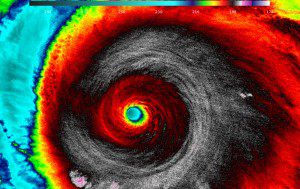
When NASA-NOAA's Suomi NPP satellite passed over Patricia on Oct. 23, 2015, its VIIRS instrument looked at the storm in infrared light. Cloud-top temperatures of thunderstorms around the eyewall were between 180-190 Kelvin (-135.7F/-93.1C to -117.7F/-83.1C). (Credit: UW/CIMSS/William Straka III)
Hurricane Patricia made landfall on Oct. 24, 2015, along the southwestern coast of Mexico. NASA's Aqua satellite captured Patricia making landfall, while the Global Precipitation Measurement mission core satellite added up Patricia's high rain totals, which exceeded more than 409 millimeters (16.1 inches) over open waters.
Hurricane Patricia made history when it became the strongest storm ever recorded in the Western Hemisphere, with maximum sustained winds reported at 200 mph by the National Hurricane Center, said Research Meteorologist Steve Lang.
Patricia’s estimated minimum central pressure of 880 millibars was also the lowest ever recorded in the Western Hemisphere. For comparison, Hurricane Katrina, the costliest storm in U.S. history, had a minimum central pressure of 902 millibars and peak sustained winds of 175 mph.

